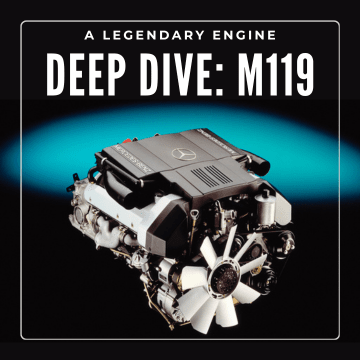Deep Dive: The M119 Engine from Mercedes-Benz
11th Apr 2023
When the R129 SL first debuted in 1989 the options were three fold:
1) The relatively agricultural 12 valve, single cam, M103-powered 300 SL,
2) It’s peppy twin cam younger sibling, the M104-powered 300 SL 24V,
…both of which were available with a dogleg 5 speed manual gearbox in some markets! A rare find…

R129 with a dogleg manual gearbox. Autotrader
…or 3) The all new dual overhead cam M119 V8-powered 500 SL:

An early R129 500 SL. Sonderklasse Motors
The powerplant of the latter shall be today’s focus.

The M119 DOHC V8 Engine. Car Throttle
First surfacing in the late 80s, ripe and ready for a fresh decade, the M119 V8 engine was essentially brand new state of the art aluminium cylinder heads bolted onto a very similar (but not identical) block to the outgoing M117 V8, a staple of Mercedes’ product offering since the early 70s. The introduction of this new engine marked the beginning of a very special era for Mercedes’ consumer operations and their racing endeavours alike.

R129 advert from the 90s, peak Mercedes. Mercedes-Benz Group Media
The M119’s large heads had 4 valves per cylinder (as opposed to 2 for the outgoing M117) and variable valve timing on the intake camshaft, both considerable upgrades for the time. The internals were beefed up with forged connecting rods and cast aluminium pistons. Vastly superior lubrication technologies were also deployed.
The results were monstrous. In its ‘purest’ early form, utilising Bosch’s fairly ancient K-Jetronic (or CIS - Continuous Injection System as it’s known in the USA) mechanical fuel injection system (in its updated electronically-controlled form known as KE-Jetronic), the M119 (119.960)-powered 500 SL churned out 322 horsepower and a whopping 480 Nm of torque fresh from the factory. And they were just the published figures - rumour has it those early cars were often more powerful than the official numbers would have us believe. Well maintained cars are still potently good fun albeit hilariously thirsty, not that that’s a big concern of yours when getting into this type of vehicle.

Another early two-tone R129 with the later monoblock AMG wheels. Collecting Cars
Though KE-Jetronic cars can run to the moon and back with fastidious maintenance, technicians who can tune the mechanical injection system the correct way are becoming fewer and further between. This combined with dwindling parts availability can make the early cars a more daunting proposition.
For the 500 SL’s 1993 model year the second generation M119 V8 was introduced (119.970 - 119.975) having debuted in the first version of the Porsche-engineered W124 500 E.

Mercedes W124 500 E 6.0 AMG, precursor to the post-merger E60. Collecting Cars
The fuel injection system was updated to Bosch LH-Jetronic, a more contemporary digital system that utilised a mass air flow sensor (see our stock) and an electronic slide valve throttle body (see our stock). The mass air flow sensor (or MAF sensor as it’s typically referred to) converts highly precise air mass (or volume) readings into fuel injection quantities via a computer. This made for a more efficient and less thirsty combustion process with, on paper, negligible power losses. Depending on who you ask, it’s the LH system that offers supreme reliability and, if you’re lucky, straightforward maintenance.
By 1996 the R129 SL had matured somewhat, with a handful of incremental updates under its belt. This model year signalled the first major facelift for Mercedes’ flagship vehicle.

A 1996 facelifted R129 SL. Car and Classic
Now named the SL 500, as of the 1994 model year redesignation, on top of cosmetic and electronic changes across the board there was another key update to the M119 engine; the introduction of Bosch Motronic (119.980 - 119.985). Though still essentially LH-jetronic, this was now a part of a more compact and integrated fuel and ignition system which featured a modern distributorless wasted spark setup. For many, the final iteration of this engine in Motronic form is the most refined and accessible in terms of maintenance. OBD-II was now mandatory and so digital diagnostics ruled the roost. If you’re in the market for an M119-powered vehicle and are most concerned with reliability, affordable maintenance and comparative peace of mind this may be the one for you. For the R129s model year 1999, Mercedes introduced the M119’s more basic single overhead cam successor, the M113. A great engine in its own right, but R129 aficionados tend to favour the earlier V8 models.
The M119 engine’s potential was pushed to the max in a heavily tuned setup for the Sauber C9, a Group C race car sporting two turbos and upwards of 800 horsepower.

The twin turbo M119HL engine used in the Sauber C9. Race Cars Direct
This thing decimated the 24 Hours of Le Mans in 1989:

Sauber C9, the Le Mans winning Group C race car. Classic Driver
A naturally aspirated version of the M119 was used in the CLK LM, a more or less identical twin to the CLK GTR that was developed by Mercedes-Benz and AMG for the FIA GT Championship. A road-legal version was also made. The car won every race in the 1998 FIA GT season, except for the 24 Hours of Le Mans.

CLK LM, the CLK GTRs rarer sibling, powered by a version of the M119 engine. WIkipedia
Mercedes specialist Pierre Hedary speculates that it was the boffins in Affalterbach that provided some of the key inspiration for the M119. The AMG-modified M117 quad cam engine found in some iconic period AMG-converted ‘Hammers’ for example, appears to bear some resemblance.

Pierre Hedary - a highly recommended subscribe for all classic Mercedes enthusiasts.
Watch at
Mercedes Classics with Pierre Hedary Youtube Channel
If you’ve got an M119-powered vehicle, you’ve got one of the best engines Mercedes-Benz have ever made. Enjoy it, and contact us any time you need parts or advice.

